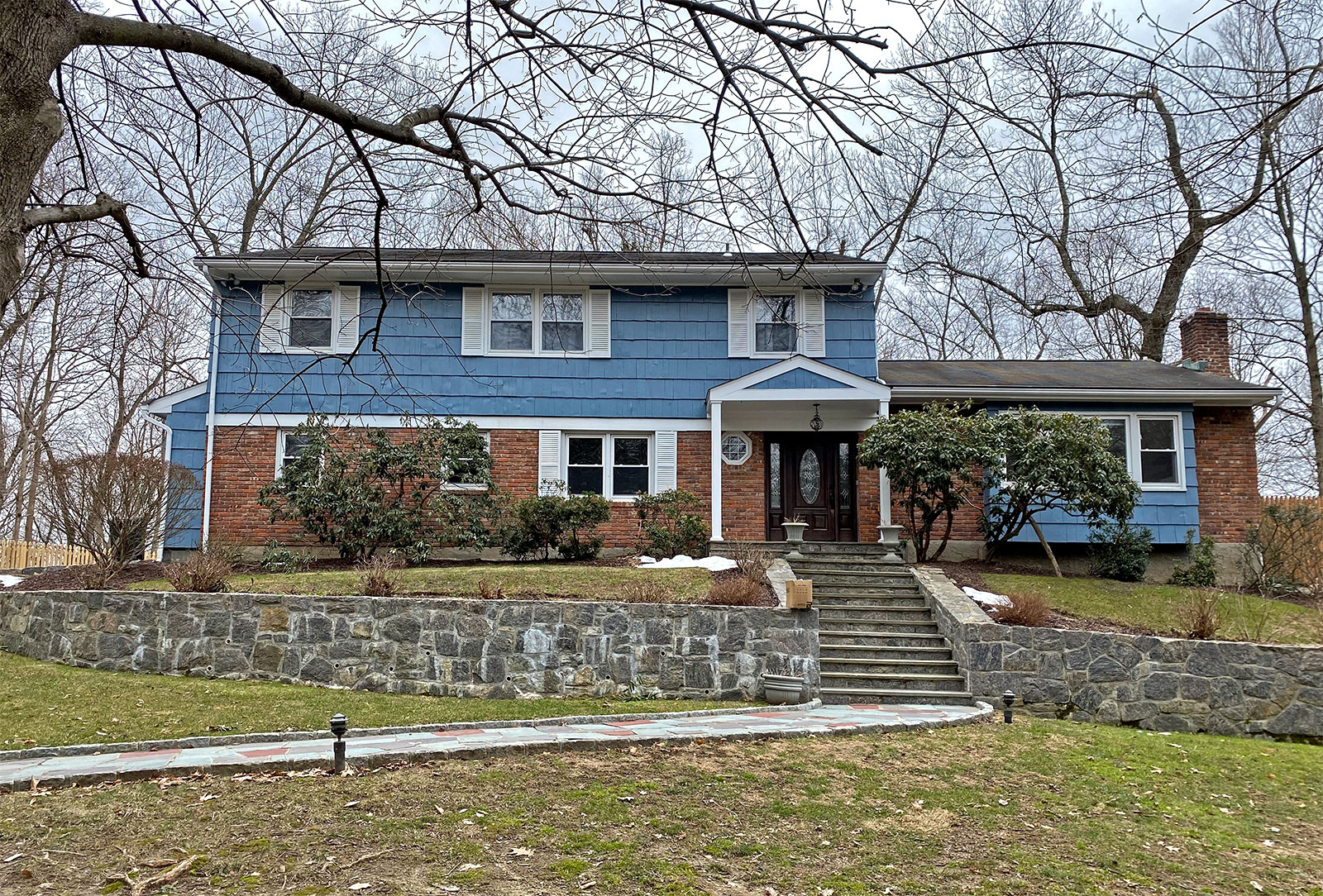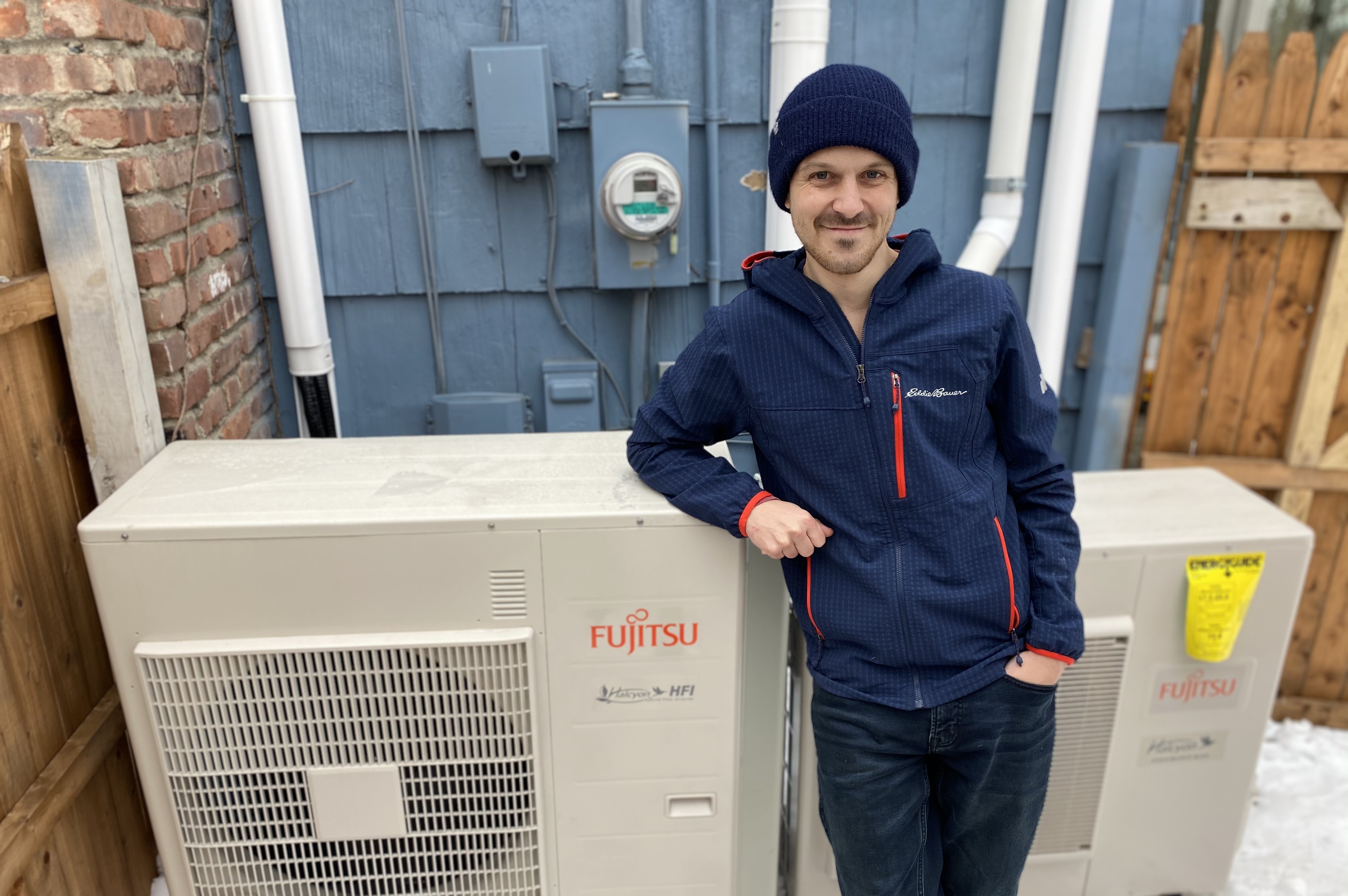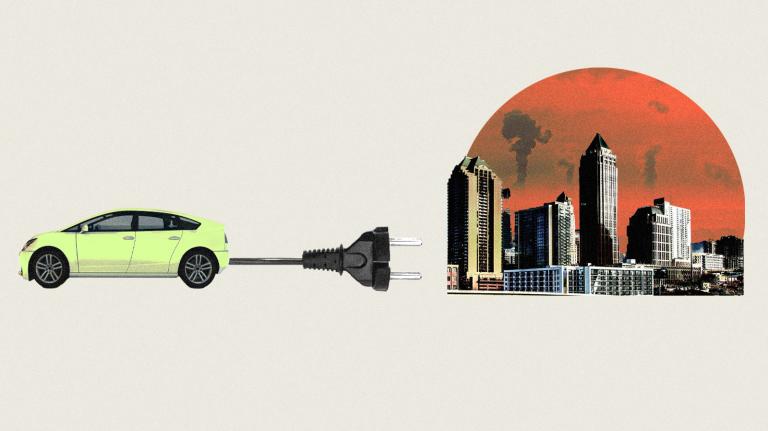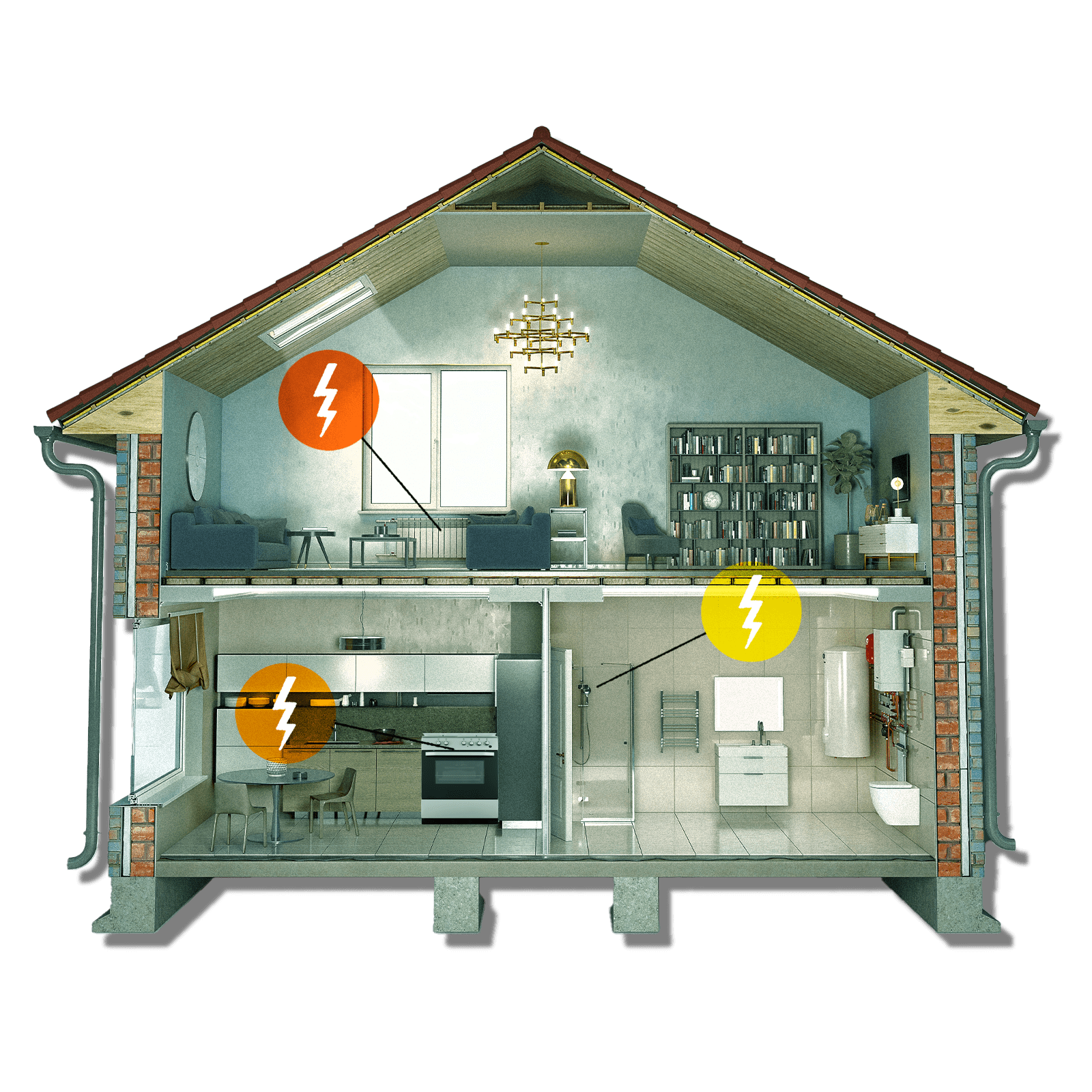Adam James had been casually browsing the housing market for about a year when he came across a home that seemed like the perfect fit. The 31-year-old and his wife recently had their third child, and the 1960s split-level ranch house in Ossining, New York, a village on the Hudson River with ample green space and a commuter train station, was just what they were looking for. The house had only one downside: Its oil-based heating system was 35 years old and on the brink of sputtering out.
Except that wasn’t a downside for James, who works as chief of staff at Energy Impact Partners, a sustainable energy investment firm. “I was actually excited because I was like, I’m gonna get this thing off of fuel oil and decarbonize it,” he told Grist last October.
By that he meant he wanted to switch out the heating and hot water systems in the house for appliances that run on electricity. This kind of conversion is called electrification, and it is currently the only proven way to eliminate the carbon emissions directly generated by our buildings. But even in New York state, which has a legal mandate to cut emissions 85 percent by 2050, a goal of getting 130,000 electric heat and hot water systems installed by 2025, and several public and private programs that promote and incentivize electric heating, James had an unexpected amount of trouble getting it done.
Any state seeking to electrify its buildings will face lots of challenges — recalcitrant homeowners who don’t want to rip out their existing appliances, the natural gas industry fighting to preserve its relevance, pipelines and other infrastructure to wind down, a diverse building stock with no one-size-fits-all solution, high upfront costs that many cannot afford, and, in rental housing, the risk of passing those costs on to low-income tenants. Electrification programs will depend on early adopters like James having good experiences and recommending the technology to their friends. But James’ saga warns of a more fundamental obstacle: getting contractors and other building professionals on board.
Back in college, James had studied “environmental pragmatism,” a branch of philosophy that aims to move the discipline away from theoretical debates over the value of nature toward more practical applications aimed at addressing environmental crises like climate change. That shift played out in real life for him when he later chose to leave academia to pursue a career in clean energy.
For a long time, though, he’d had to make concessions to the ubiquity of fossil fuel infrastructure in his personal life. He couldn’t afford an electric vehicle, and before he bought the house in Ossining, his family was renting apartments and houses where they didn’t have the power to make climate-friendly improvements. “That was always really depressing for me,” he said.
Renovating his new home was a major chance to live out his values. Eventually, James hopes to make the whole house carbon-negative by installing solar panels and batteries, and maybe even buying carbon offsets to make up for the emissions associated with the building’s construction. But his first priority? Get rid of the dirty heating system.

The first thing James did was call a few local contractors to ask about geothermal heat pumps, highly efficient systems that absorb heat from the near-constant temperature beneath the earth’s surface and transfer it into your home. But he quickly learned that it was going to cost a lot more than he thought — around $40,000, by one estimate. So James gave up on geothermal and began looking into air-source heat pumps, similar systems that instead absorb heat from the outdoor air, even on cold winter days. He found a list of contractors on the website for New York’s Energy Research and Development Authority, or NYSERDA, a state agency tasked with promoting energy efficiency and renewables. The contractors on the list were ostensibly certified to install heat pumps, and James said he called about 10 of them just to figure out what his options were.
Several didn’t respond to his inquiry. A few told him they didn’t do heat pumps. The rest said they could install heat pumps but tried to talk him out of it, explaining that a heat pump would be more expensive than a fuel oil system or a propane furnace, and that he would still need one of those as a backup source of heat. (The local natural gas utility, Con Edison, currently has a moratorium on new customers in Ossining, so gas heating was not an option for James.)*
Why were contractors so allergic to the idea of selling James the technology he was asking for? “If you want to raise hackles, tell a contractor what to do,” said Nate Adams, a home performance specialist based in Ohio who goes by the nickname the “House Whisperer,” in a recent webinar on how to sell heat pumps to contractors and homeowners.
Adams said some contractors are afraid of heat pumps because earlier generations of the technology were noisy and didn’t work well in colder temperatures. The technology has come a long way, and new, cold-climate heat pumps work just fine in places like New York, but contractors still perceive them as riskier than traditional systems. “We have 105,000 HVAC contractors across the U.S. that have to be convinced this is a good idea,” said Adams, using the acronym for heating, ventilation, and air conditioning.
There’s disagreement about heat pump effectiveness even among contractors who recommend the technology. In February, about five months after James’ ordeal, I called several contractors from the same list James consulted and reached Scott Carey, a contractor in Briarcliff, New York, who installs heat pumps for clients and even recently put them in his own house. However, he recommends that his customers keep a back-up source of heat, such as a propane furnace, for when the heat pump periodically goes into defrost mode, running the system in reverse and pumping cold air into the house.
Daphney Warrington, who runs an HVAC company called Breffni Mechanical with her husband in Yonkers, New York, and also installs heat pumps, disagreed — she said there was no need for a backup system unless the homeowner wanted to have one. When asked about James’ trouble finding a contractor, Warrington and Carey offered a similar assessment — a lot of contractors are old school and haven’t stayed up to date with the latest technology. “They still are thinking that heat pumps aren’t for this part of the country,” said Carey.
In its 2020 clean heat market development plan, NYSERDA recognized that there is a shortage of expert, qualified labor to design and install clean heating and cooling systems, as well as a reluctance in the contractor community to transition their business to emphasize clean heating. The agency’s goal is to train 14,000 workers across the heat pump supply chain, including at least 4,200 to directly sell and install systems. It has already dedicated more than $100 million to workforce development and training through 2025. It also plans to invest in demonstration projects in order to produce proven project designs and business models that contractors can replicate.
But part of the problem may be that New York state has not sent a clear signal to the heating and cooling workforce that this is the direction it’s going in. The state utility commission has acknowledged that electrification is key to achieving the state’s climate goals, and has poured hundreds of millions of dollars into programs to incentivize heat pumps. But there are no state laws compelling homeowners or developers to go electric, and the state has simultaneously allowed many of its natural gas utilities to expand. New York still has laws on the books that subsidize the expansion of the gas system.
“There’s really nothing in the New York state building energy codes that requires or even really incentivizes building all-electric,” said Amy Turner, a senior fellow for the Cities Climate Law Initiative at Columbia University. “We’re sort of seeing incremental improvements to the building code every code cycle, but they tend to focus on efficiency and energy conservation as opposed to that wholesale switch to electrification that we’re eventually going to need.”
Bill Nowak, the executive director of the New York Geothermal Energy Organization, a trade association, said he hopes to see New York adopt an end date for fossil fuel heating — starting by banning it in new construction, as cities in California have done, but eventually setting a point after which fossil fuel appliances could simply not be sold. Nowak is on the energy efficiency and housing advisory panel to the Climate Action Council, a government-appointed group tasked with mapping out how New York can meet its climate targets, and said the panel is looking into sending some kind of market signal like this. “That can’t happen soon enough in terms of really rightsizing the workforce and getting things ready to go so it’s an easy glide for people,” he said.
Transitioning the workforce isn’t just about getting contractors on board — electrification policy can also be a significant engine for job creation. A 2019 study found that decarbonizing the building stock in California could create 100,000 permanent jobs in the state, not just working on buildings directly but also in manufacturing electrical equipment and appliances, and updating electrical infrastructure to ensure it can handle increased demand. President Joe Biden ran for office on a plan to create at least 1 million good-paying jobs retrofitting the nation’s buildings and electrifying home appliances.
After many phone calls and little progress, James started posting on Twitter about his misadventures in electrification. Luckily, internet friends soon connected him with a New York–based company called BlocPower, a one-stop shop for building electrification. (BlocPower’s CEO, Donnel Baird, was a Grist 50 Fixer in 2017.) BlocPower helped James choose a heating and hot water system, tailor them to his house, take out a loan to pay for them, and hire contractors to install them. The company also helped him get an $11,720 rebate for the heating system, and a $1,250 rebate for an electric hot water heater, both through his electric utility, Con Edison. All in all, it was a success. By the time James’ family moved in on New Year’s Eve, a month after they closed on the house, the new electric heating and hot water systems were up and running, and the house was even toastier than he expected.

When asked how he thought the process could be improved, James suggested a more accurate list of contractors who install heat pumps than the one he found on NYSERDA’s website and a way to compare your costs to completed projects in similar houses. NYSERDA does have a page that would have connected James to a local community organization that could have helped him with his search, as well as a data repository containing some of the cost information he was looking for, but they don’t seem to be easy enough for consumers to find. In its market development plan, the agency said it aimed to develop better online resources for consumers, including a single landing page for all of its heat pump program offerings.
It’s possible things are already improving, as illustrated by my own experience reaching out to contractors on NYSERDA’s list and easily finding three who were enthusiastic about heat pumps. A spokesperson for NYSERDA told Grist that the agency is continually working to maintain and update the list.
James also said there should be more financial incentives, such as allowing the monthly payments on his loan to be tax deductible, much like mortgage interest payments. His total bill was about $20,000, much more than he was expecting. By comparison, he said, a new propane furnace would have cost him about $4,000. “It’s crazy. I mean, it’s basically the equivalent of getting another car and having car payments,” he said. “That’s what this looks like for us financially. Except instead of buying a second car to cruise around town, we’re getting an HVAC system.”
*Correction: This article previously stated that “burning fuel oil or propane is much worse for the climate than burning natural gas.” Natural gas has a lower emissions intensity than propane or fuel oil, but some analyses have found that when you account for additional emissions associated with connecting a home to the natural gas system, such as methane leaks from pipelines and the additional gas burned in new appliances such as clothes dryers and stoves, gas-connected homes have a larger greenhouse gas footprint than homes that use oil or propane.





